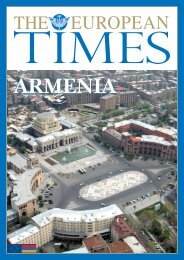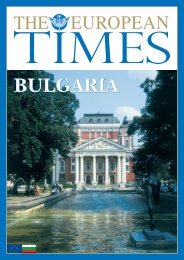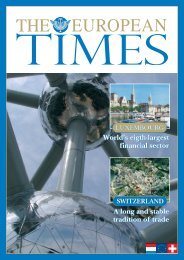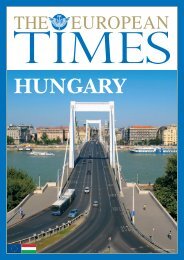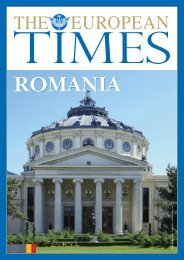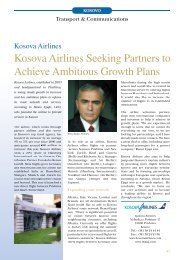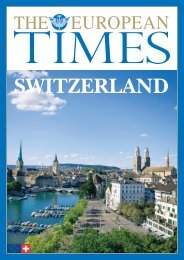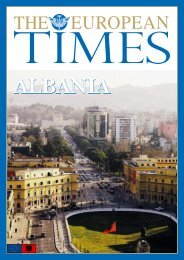Download Kosovo Report - The European Times
Download Kosovo Report - The European Times
Download Kosovo Report - The European Times
Create successful ePaper yourself
Turn your PDF publications into a flip-book with our unique Google optimized e-Paper software.
KOSOVO<br />
Transport & Communications<br />
the Government’s Main Target Is<br />
Infrastructure<br />
route. For roads the routes in<br />
question span 310 km and are<br />
route 6 (Ribarevina in Montenegro<br />
to Skopje in Macedonia) and route<br />
7 (Lezhe in Albania to Doljevac<br />
in Serbia) while for rail it lies on<br />
route 10 (from Kraljevo in Serbia<br />
to Gorce Petrov in Macedonia).<br />
Consequently, the government has<br />
made the development of route 6<br />
and 7 a high priority as significant<br />
transport arteries for the country<br />
and the region connecting with<br />
neighbouring capital cities.<br />
While a recent Department of Road<br />
Infrastructure (DRI) survey found<br />
that 88% of primary roads and 74%<br />
of the regional roads are in good<br />
condition, there is still a significant<br />
amount of investment needed to<br />
upgrade the 8,000 km road network<br />
in <strong>Kosovo</strong>. This includes the urban<br />
transport network and infrastructure<br />
which needs to meet the needs of a<br />
growing population. In the period<br />
2000-2005, €136 million was spent<br />
on road infrastructure investments<br />
and this looks set to increase in the<br />
coming years. Indeed, in 2006 alone,<br />
the government estimated that there<br />
was a need for €70 million investment<br />
in the road network. As the economy<br />
grows, this is likely to become ever<br />
more necessary with the motorisation<br />
levels in the country rising from<br />
their current levels of 105 passenger<br />
cars per 1,000 persons towards the<br />
EU average of 418 passenger cars per<br />
1,000 persons.<br />
However, the government is also<br />
keen to ensure that the rail network<br />
can meet the country’s passenger<br />
and freight requirements. <strong>Kosovo</strong><br />
currently has a 333 km single<br />
track non-electrified rail system<br />
with standard gauge, which is in<br />
good condition. <strong>The</strong> country will<br />
be looking to expand its rolling<br />
stock, however, which currently<br />
consists of nine locomotives, four<br />
Diesel Multiple Units (DMUs), ten<br />
passenger carriages and 70 freight<br />
wagons. As GDP continues to take<br />
an upward turn, freight traffic in the<br />
country has increased. Indeed, freight<br />
carried by rail rose from 345,000<br />
tonnes in 2006 to 588,000 tonnes<br />
in 2007. Passenger numbers have<br />
also risen in recent years climbing<br />
by 4.25% between 2006 and 2007 to<br />
417,000 passengers. <strong>Kosovo</strong> Railways<br />
(KR) is also looking to expand their<br />
services with a line opened between<br />
Prishtina and Skopje and another<br />
in the pipeline for commercial<br />
passenger services to Peja. KR is also<br />
considering an express train service<br />
to Prishtina Airport.<br />
Beyond investment and network<br />
expansions, the government has<br />
tried to bind itself to the <strong>European</strong><br />
regulatory environment. In June<br />
2006, the UN Mission in <strong>Kosovo</strong><br />
(UNMIK) on behalf of <strong>Kosovo</strong> signed<br />
the <strong>European</strong> Common Aviation<br />
Area (ECAA) Agreement. <strong>The</strong> ECAA<br />
provides the framework for a single<br />
market for aviation covering 35<br />
countries and 500 million people.<br />
<strong>The</strong> agreement will gradually<br />
extend complete <strong>European</strong> aviation<br />
legislation to all its members. In<br />
June 2004, UNMIK also signed an<br />
MOU on the Development of the<br />
South East Europe Core Regional<br />
Transport Network (SEECRTN)<br />
which will provide a unified strategy<br />
for regional transport policy in South<br />
East Europe.<br />
<strong>The</strong> future of <strong>Kosovo</strong> is therefore<br />
firmly embedded within regional<br />
policies on transport. To achieve<br />
this, however, the country will need<br />
to upgrade its transport network<br />
through a series of PPP investments.<br />
Indeed, future growth in the sector<br />
will be fuelled by the private sector.<br />
37



